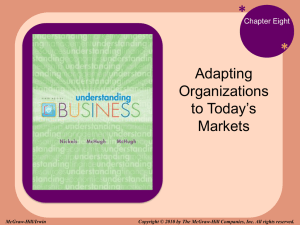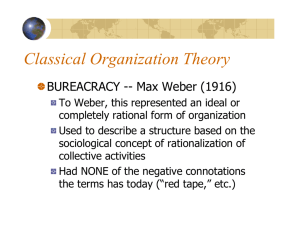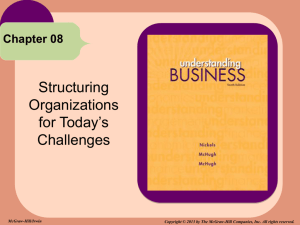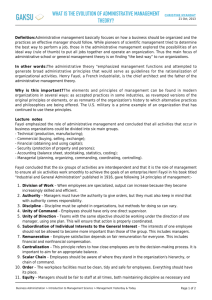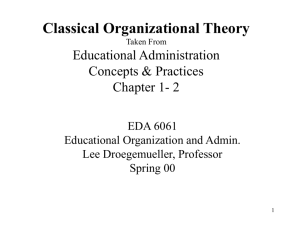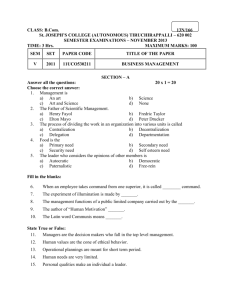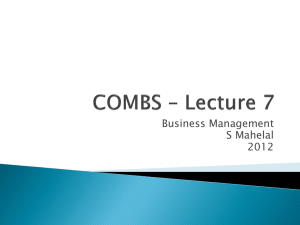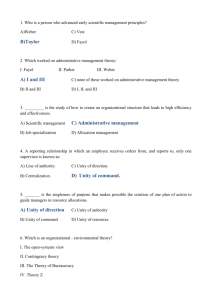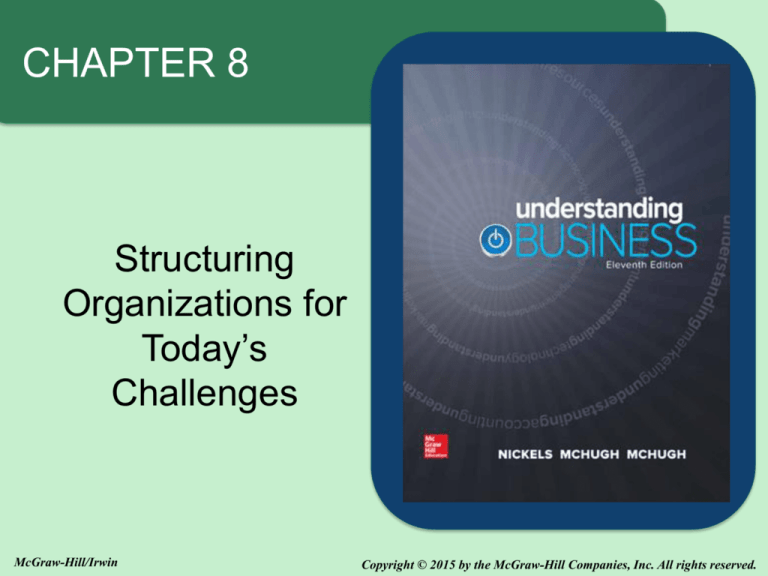
CHAPTER 8
Structuring
Organizations for
Today’s
Challenges
McGraw-Hill/Irwin
Copyright © 2015 by the McGraw-Hill Companies, Inc. All rights reserved.
LEARNING OBJECTIVES
1. Outline the basic principles of organization management.
2. Compare the organizational theories of Fayol and Weber.
3. Evaluate the choices managers make in structuring
organizations.
4. Contrast the various organizational models.
5. Identify the benefits of inter-firm cooperation and
coordination.
6. Explain how organizational culture can help businesses
adapt to change.
8-2
JENNA LYONS
J. Crew
• Joined J. Crew in 1990 as a junior
designer.
• Worked her way up the ladder by
emphasizing her commitment to
quality.
• Her management style is
compassionate and understanding.
8-3
NAME that COMPANY
This company maintains strict written rules and
decision guidelines. Those rules enable the firm
to deliver packages quickly because employees
don’t have to pause to make decisions –
procedures are clearly spelled out for them.
Name that company!
8-4
REORGANIZATION is for
EVERYONE
LO 8-1
• Many companies are reorganizing, especially those
in decline. Including:
- Auto makers
- Homebuilders
- Banks
• Adjusting to changing markets is normal in capitalist
economies.
• Companies must go back to basic organizational
principles and firm up the foundation.
8-5
STRUCTURING an ORGANIZATION
LO 8-1
• Create a division of labor
• Set up teams or departments
• Allocate resources
• Assign tasks
• Establish procedures
• Adjust to new realities
8-6
WOULD YOU SACRIFICE
SAFETY for PROFITS?
You own a lawn-mowing business and are aware of
the hazards in the job. But you’ve seen other
companies save money by eliminating safety
equipment. You’d also like to make more money.
• What do you do?
• Save money with less
safety precautions?
• What are the
consequences?
8-7
THE CHANGING ORGANIZATION
LO 8-2
• Often change in organizations is due to evolving
business environments:
- More global competition
- Declining economy
- Faster technological change
- Pressure to protect the environment
• Customer expectations have also changed -Consumers today want high-quality products with
fast, friendly service and all at low cost.
8-8
HOW MUCH CHANGES
in a DECADE?
LO 8-2
What?
2000
2010
Amount of cell phone use
34%
89%
Number of active blogs
12,000
141,000,000
Amount of reality shows
4
320
Daily emails sent
12 billion
247 billion
Number of hours spent online per week
2.7
18
Number of daily newspapers
1,480
1,302
Number of daily letters mailed
207 billion
175 billion
Amount of books published
282,242
1,052,803
iTunes downloads
0
10 billion
Percentage of obese Americans
26%
34%
Source: Fast Company, www.fastcompany.com, accessed March 2014.
8-9
PRODUCTION CHANGED
ORGANZIATION DESIGN
LO 8-2
• Mass production of goods led to complexities in
organizing businesses.
• Economies of Scale -Companies can reduce
their production costs by
purchasing raw materials
in bulk.
• The average cost of
goods decreases as
production levels rise.
8-10
FAYOL’S PRINCIPLES
• Unity of command
• Hierarchy of authority
• Division of labor
• Subordination of
individual interests to
the general interest
• Authority
LO 8-2
• Degree of
centralization
• Clear communication
channels
• Order
• Equity
• Esprit de corps
8-11
ORGANIZATIONS BASED on
FAYOL’S PRINCIPLES
LO 8-2
• Organizations in which
employees have no more
than one boss; lines of
authority are clear.
• Rigid organizations that often
don’t respond to customers
quickly.
8-12
WEBER’S PRINCIPLES
LO 8-2
• Employees just need to do what
they’re told.
• In addition to Fayol’s principles,
Weber emphasized:
- Job descriptions
- Written rules, decision guidelines
and detailed records
- Consistent procedures,
regulations and policies
- Staffing and promotion based on
qualifications
8-13
HIERARCHIES and COMMAND
LO 8-2
• When following Fayol and Weber, managers
control workers.
• Hierarchy -- A system in which one person is at the
top of an organization and there is a ranked or
sequential ordering from the top down.
• Chain of Command -- The line of authority that
moves from the top of the hierarchy to the lowest
level.
8-14
ORGANIZATIONAL CHARTS
LO 8-2
• Organization Chart -A visual device that
shows relationships
among people and
divides the organization’s
work; it shows who
reports to whom.
7-15
TYPICAL ORGANIZATION CHART
LO 8-2
8-16
BUREAUCRATIC ORGANIZATIONS
LO 8-2
• Bureaucracy -- An organization with many layers of
managers who set rules and regulations and oversee
all decisions.
• It can take weeks or months to have information
passed down to lower-level employees.
• Bureaucracies can annoy customers.
8-17
TEST PREP
• What do the terms division of labor and job
specialization mean?
• What are the principles of management outlined
by Fayol?
• What did Weber add to the principles of Fayol?
8-18
CENTRALIZATION or
DECENTRALIZATION?
LO 8-3
• Centralized Authority -- When decision-making is
concentrated at the top level of management.
• Decentralized
Authority -- When
decision-making is
delegated to lower-level
managers and employees
more familiar with local
conditions than
headquarters is.
8-19
CENTRALIZATION and
DECENTRALIZATION
LO 8-3
8-20
SPAN of CONTROL
LO 8-3
• Span of Control -- The optimal number of
subordinates a manager supervises or should
supervise.
• When work is standardized, broad spans of
control are possible.
• Appropriate span narrows at higher levels of the
organization.
• The trend today is to reduce middle managers
and hire better low-level employees.
8-21
ORGANIZATIONAL STRUCTURES
LO 8-3
• Structures determine the way the company
responds to employee and customer needs.
• Tall Organization Structures -- An organizational
structure in which the organization chart would be tall
because of the various levels of management.
• Flat Organization Structures -- An organizational
structure that has few layers of management and a
broad span of control.
8-22
FLAT ORGANIZATIONAL
STRUCTURE
LO 8-3
8-23
ADVANTAGES and DISADVANTAGES of
the DIFFERENT SPANS of CONTROL
LO 8-3
8-24
DEPARTMENTALIZATION
LO 8-3
• Departmentalization -- Divides organizations into
separate units.
• Workers are grouped by skills and expertise to
specialize their skills.
8-25
ADVANTAGES of
DEPARTMENTALIZATION
LO 8-3
1) Employees develop skills and progress within a
department as they master skills.
2) The company can achieve economies of scale.
3) Employees can coordinate work within the
function and top management can easily direct
activities.
8-26
DISADVANTAGES of
DEPARTMENTALIZATION
LO 8-3
1) Departments may not communicate well.
2) Employees may identify with their department’s
goals rather than the organization’s.
3) The company’s response to external changes may
be slow.
4) People may not be trained to take different
managerial responsibilities, instead they become
specialists.
5) Department members may engage in groupthink and
may need outside input.
8-27
WAYS to DEPARTMENTALIZE
LO 8-3
8-28
WAYS to DEPARTMENTALIZE
LO 8-3
8-29
TEST PREP
• Why are organizations becoming flatter?
• What are some reasons for having a narrow span
of control in an organization?
• What are the advantages and disadvantages of
departmentalization?
• What are the various ways a firm can
departmentalize?
8-30
FOUR WAYS to STRUCTURE an
ORGANIZATION
LO 8-4
1. Line Organizations
2. Line-and-Staff
Organizations
3. Matrix-Style
Organizations
4. Cross-Functional SelfManaged Teams
8-31
LINE ORGANIZATIONS
LO 8-4
• Line Organization -- Has direct two-way lines of
responsibility, authority and communication running
from the top to the bottom. Everyone reports to one
supervisor.
• There are no specialists, legal, accounting,
human resources or information technology
departments.
• Line managers issue orders, enforce discipline
and adjust the organization to changes.
8-32
LINE PERSONNEL
LO 8-4
• Line Personnel -- Workers responsible for directly
achieving organizational goals, and include
production, distribution and marketing employees.
• Line personnel have authority to make policy
decisions.
8-33
STAFF PERSONNEL
LO 8-4
• Staff Personnel -- Employees who advise and assist
line personnel in meeting their goals, and include
marketing research, legal advising, IT and human
resource employees.
8-34
SAMPLE LINE-and-STAFF
ORGANIZATION
LO 8-4
8-35
MATRIX ORGANIZATIONS
LO 8-4
• Matrix Organization -- Specialists from different
parts of the organization work together temporarily on
specific projects, but still remain part of a line-and-staff
structure.
• Emphasis is on
product development,
creativity, special
projects,
communication and
teamwork.
8-36
SAMPLE MATRIX
ORGANIZATION
LO 8-4
8-37
ADVANTAGES of the
MATRIX STYLE
LO 8-4
• Managers have flexibility in assigning people to
projects.
• Interorganizational cooperation and teamwork is
encouraged.
• Creative solutions to product development
problems are produced.
• Efficient use of organizational resources.
8-38
DISADVANTAGES of the
MATRIX STYLE
LO 8-4
• It’s costly and complex.
• Employees may be confused about where their
loyalty belongs.
• Good interpersonal skills and cooperative
employees are a must.
• It’s a temporary
solution to a possible
long-term problem.
• Teams are not
permanent.
8-39
CROSS-FUNCTIONAL
SELF-MANAGED TEAMS
LO 8-4
• Cross-Functional Self-Managed Teams -Groups of employees from different departments who
work together on a long-term basis.
• A way to fix the problem of matrix-style teams is
to establish long-term teams.
• Empower teams to work closely with suppliers,
customers and others to figure out how to create
better products.
8-40
GOING BEYOND
ORGANIZATIONAL BOUNDARIES
LO 8-4
• Cross-functional teams work best when the voice
of the customer is heard.
• Teams that include customers, suppliers and
distributors go beyond organizational boundaries.
• Government coordinators may assist in sharing
market information beyond national boundaries.
8-41
BUILDING SUCCESSFUL TEAMS
LO 8-4
Important Conditions for Small Teams
• Clear purpose
• Clear goals
• Correct skills
• Mutual accountability
• Shift roles when
appropriate
Source: CIO Magazine, www.cio.com, accessed November 2014.
8-42
TEST PREP
• What’s the difference between line and staff
personnel?
• What management principle does a matrix-style
organization challenge?
• What’s the main difference between a matrixstyle organization’s structure and the use of
cross-functional teams?
8-43
REAL-TIME BUSINESS
LO 8-5
• Networking -- Using communications technology to
link organizations and allow them to work together.
• Most companies are no longer self-sufficient;
they’re part of a global business network.
• Real Time -- The present moment or actual time in
which something takes place.
8-44
TRANSPARENCY and VIRTUAL
CORPORATIONS
LO 8-5
• Transparency -- When a company is so open to
other companies that electronic information is shared
as if the companies were one.
• Virtual Corporation -- A temporary networked
organization made up of replaceable firms that join
and leave as needed.
8-45
A VIRTUAL CORPORATION
LO 8-5
8-46
CUTTING BACK WHILE
CUTTING COSTS
• Hiring workers is a major
expense for small business
owners.
• This has led to more offshore
outsourcing.
• The increase can be partly
attributed to the presence of
online job marketplaces like
ODesk.
8-47
BENCHMARKING and
CORE COMPETENCIES
LO 8-5
• Benchmarking -- Compares an organization’s
practices, processes and products against the
world’s best.
• Core Competencies -- The functions an
organization can do as well as or better than any
other organization in the world.
• K2 Skis researched other companies’ practices
in order to create the best possible skis and
snowboards.
8-48
BENEFITS and CONCERNS of
HEALTHCARE OUTSOURCING
Benefits
LO 8-5
Concerns
• Provides enough
staff to operate the
facility
• Lower employee
morale
• Cost savings
• Liability
• Should patients be
informed
• Confidentiality and
security
Source: Healthcare Financial Management.
8-49
WHICH JOBS are most often
OUTSOURCED?
Source: USA Today.
LO 8-5
8-50
ADAPTING to
MARKET CHANGES
LO 8-5
• Change isn’t easy.
Employees like to do
things the way they
always have.
• Get rid of old, inefficient
facilities and equipment.
• Use the Internet to get to
know your customers and
sell directly to them.
8-51
KEEP in TOUCH
LO 8-5
Amazon and its Customer Database
Amazon uses information stored in databases to
reach out to customers. The company emails
customers letting them know about music, DVDs
or books they might like based on past purchases.
• Have you ever received an email like this from Amazon or another
company?
• What benefits would a database of personal information, like past
purchases, provide Amazon?
• Do you think these databases are helpful for both companies and
consumers or are they an invasion of privacy?
8-52
LO 8-5
MAKING the CHANGE
• Digital Natives -Young people who
have grown up using
the Internet and
social networking.
Photo Credit: Marc Wathieu
8-53
WHEN OPEN COMMUNICATION
SHOULD NOT BE SO OPEN
• The blending of mobile
technology and work has been
helpful to business.
• However, it also has encroached
on the traditional work-life
boundaries.
• Over 1/3 of surveyed employees
responded that receive workrelated emails after hours, many
complain it affects quality of life.
8-54
RESTRUCTURING
LO 8-5
• Restructuring -- Redesigning an organization so it
can more effectively and efficiently serve its
customers.
• Inverted Organization -- An organization that has
contact people at the top and the CEO at the bottom
of the organizational chart.
• The manager’s job is to assist and support
frontline workers, not boss them.
8-55
TRADITIONAL and INVERTED
ORGANIZATIONS
LO 8-5
8-56
ORGANIZATIONAL CULTURE
LO 8-6
• Organizational or Corporate
Culture -- The widely shared
values within an organization that
foster unity and cooperation to
achieve common goals.
• Some of the best organizational
cultures emphasize service.
• Culture is shown in stories,
traditions and myths.
8-57
FORMAL ORGANIZATION
LO 8-6
• Formal Organization -- Details lines of
responsibility, authority and position.
• The formal system is often slow and
bureaucratic, but it helps guide the lines of
authority.
• No organization can be effective without formal
and informal organization.
8-58
INFORMAL ORGANIZATION
LO 8-6
• Informal Organization -- The system of
relationships that develop spontaneously as
employees meet and form relationships.
• Informal organization
helps foster
camaraderie and
teamwork among
employees.
8-59
LIMITATIONS of INFORMAL
ORGANIZATIONS
LO 8-6
• The informal system is
too unstructured and
emotional on its own.
• Informal organization
may also be powerful in
resisting management
directives.
8-60
GROUP NORMS
LO 8-6
Examples of Informal Group Norms
• Do your job but don’t produce more than the rest
of your group.
• Don’t tell off-color jokes or use profanity.
• Everyone is to be clean and organized at the
workstation.
• Respect and help your fellow group members.
• Drinking is done off the job – NEVER at work.
Source: CIO Magazine, www.cio.com, accessed November 2014.
8-61
TEST PREP
• What is an inverted organization?
• Why do organizations outsource functions?
• What is organizational culture?
8-62

